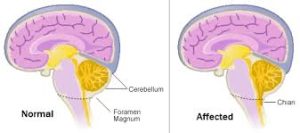The history of Chiari malformation type I could have quietly remained in the corner of neurosurgical anomalies with clear surgical indications: typical occipital headache, syringomyelia, obstructive hydrocephalus, brainstem or spinal cord compression. But no. We had to ruin it. What was once a structural diagnosis with sound criteria has now become an emotional wildcard, a totemic diagnosis, a kind of “everything goes through here” in the form of herniated cerebellar tonsils.
And then someone said: “What if Chiari also explains anxiety?”
And the worst part isn’t that someone said it. The worst part is that someone else listened… and ordered an MRI. And someone else went ahead and operated.
Editorial with a scalpel (an intellectual one)
Thankfully, Annie I. Drapeau and Anthony M. Kaufmann from Manitoba decided to write this editorial in the Journal of Neurosurgery (February 2025). Because things were getting out of hand. Their text is not just a warning; it’s an elegant slap in the face of white-coated surgical delusion. With calm, method, and references, the authors remind us of the basics: that performing posterior fossa decompression (PFD) for cognitive dysfunction without clear compressive signs is, at best, wishful thinking—and at worst, a Freudian regression with a Stryker saw.
They rightly highlight the confusion in studies lacking control groups, psychiatric baseline profiles, or medication adjustments. Improvement after surgery? It might be because they stopped topiramate. Or because someone said “everything will be fine.” Or maybe just because the neck pain is gone. But jumping from that to saying we’ve “freed trapped thoughts” is a leap that no extended foramen magnum opening can cover.
Cerebellum mania and its excesses
Of course, it doesn’t help that we’ve fallen in love with the cerebellum. Today everything is cerebellum. If the patient stumbles: ataxia. If they forget: dysmetria of thought. If they cry for no reason: cerebellar affective syndrome. If they yawn during ward rounds: expanding pontocerebellar syndrome. We’ve become such fans of the “cerebellar cognitive affective syndrome” that we’re just a couple of papers away from proposing transcranial cerebellar stimulation for procrastination and digital hypochondria.
But be careful: just because the cerebellum connects with the frontal cortex doesn’t mean it explains why your brother-in-law votes for Vox or why you feel sad some days. Attributing existential anxiety, executive dysfunction, or loss of libido to Chiari isn’t precision medicine—it’s neuropsychoanalysis in surgical scrubs.
And tomorrow?
If today we’re decompressing a Chiari for thought disorders, what’s next? Occipitocervical fusion for personality dissociation? Kyphoplasties for insecure attachment? Cosmetic cranioplasty for pathological narcissism? Spinal cord stimulators for existential emptiness?
The slippery slope is now more epistemological than clinical. We’ve moved from evidence-based neurosurgery to occurrence-based neurosurgery.
Final diagnosis: compensated surgical delusion
The editorial by Drapeau and Kaufmann deserves applause, broadcast on OR monitors, and honestly, embroidered on residents’ scrub caps. Because not everything seen on an MRI should be operated on—nor everything thought about thought.
Thought cannot be decompressed. Affectivity cannot be drained. And the posterior fossa is not a selective serotonin reuptake inhibitor.
References:
-
Drapeau AI, Kaufmann AM. Editorial. Considering Chiari malformation type I decompression for disorders of thought. J Neurosurg. 2025 Feb 21;143(1):1-3. doi: 10.3171/2024.10.JNS242051. PMID: 39983123.
-
Henry LC, McDowell MM, Stephenson TL, et al. Predecompression and postdecompression cognitive and affective changes in Chiari malformation type I. J Neurosurg. 2025 Feb 21;143(1):4-12. doi: 10.3171/2024.8.JNS241363. PMID: 39983117.
